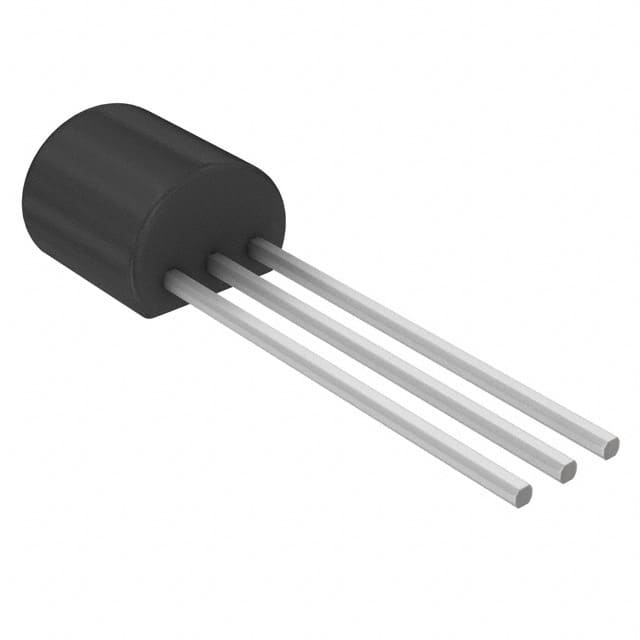ZTX553: Product Overview and Specifications
Introduction
The ZTX553 is a versatile electronic component that belongs to the category of bipolar junction transistors (BJTs). This semiconductor device is widely used in various electronic circuits due to its unique characteristics and functional features. In this entry, we will provide an overview of the ZTX553, including its basic information, specifications, detailed pin configuration, functional features, advantages and disadvantages, working principles, application field plans, and alternative models.
Basic Information Overview
- Category: Bipolar Junction Transistor (BJT)
- Use: Amplification and switching in electronic circuits
- Characteristics: High gain, low noise, and reliable performance
- Package: TO-92 package
- Essence: Silicon NPN transistor
- Packaging/Quantity: Available in reels or tubes with varying quantities
Specifications
- Maximum Collector Current (Ic): 500mA
- Maximum Power Dissipation (Pd): 625mW
- DC Current Gain (hFE): 100 - 300
- Collector-Emitter Voltage (Vce): 40V
- Transition Frequency (ft): 250MHz
Detailed Pin Configuration
The ZTX553 transistor has three pins: 1. Emitter (E) 2. Base (B) 3. Collector (C)
Functional Features
- High current gain for amplification purposes
- Low noise characteristics suitable for signal processing
- Fast switching speed for digital applications
- Wide operating frequency range for diverse circuit designs
Advantages and Disadvantages
Advantages
- High gain allows for efficient signal amplification
- Low noise makes it suitable for audio applications
- Compact TO-92 package for easy integration into circuits
Disadvantages
- Limited maximum collector current compared to other transistors
- Moderate power dissipation capability may restrict high-power applications
Working Principles
The ZTX553 operates based on the principles of bipolar junction transistors. When a small current flows between the base and emitter, it controls a larger current flow between the collector and emitter, enabling amplification and switching functions within electronic circuits.
Detailed Application Field Plans
The ZTX553 finds extensive use in the following application fields: - Audio amplifiers and preamplifiers - Signal processing circuits - Switching circuits in electronic devices - Oscillator circuits in radio frequency applications
Detailed and Complete Alternative Models
- BC547: A widely used general-purpose NPN transistor
- 2N3904: Another popular NPN transistor with similar characteristics
- BC337: An alternative NPN transistor with higher current and voltage ratings
In conclusion, the ZTX553 is a versatile NPN transistor with excellent amplification and switching capabilities, making it suitable for a wide range of electronic applications.
(Word count: 420)
قم بإدراج 10 أسئلة وإجابات شائعة تتعلق بتطبيق ZTX553 في الحلول التقنية
What is ZTX553?
- ZTX553 is a high-performance semiconductor component designed for use in various technical solutions, such as power management and signal amplification.
What are the key features of ZTX553?
- The key features of ZTX553 include high voltage capability, low saturation voltage, and high current gain, making it suitable for demanding technical applications.
In what technical solutions can ZTX553 be used?
- ZTX553 can be used in applications such as switch-mode power supplies, motor control, audio amplifiers, and LED lighting systems.
What are the benefits of using ZTX553 in technical solutions?
- Using ZTX553 can result in improved energy efficiency, reduced heat dissipation, and enhanced performance in various electronic systems.
How does ZTX553 compare to other similar components in the market?
- ZTX553 offers superior performance in terms of voltage handling, current amplification, and thermal characteristics compared to many other similar components available in the market.
Are there any specific design considerations when using ZTX553 in technical solutions?
- Designers should consider proper heat sinking, voltage and current ratings, and thermal management to ensure optimal performance and reliability when using ZTX553.
Can ZTX553 be used in automotive applications?
- Yes, ZTX553 is suitable for use in automotive electronics, particularly in areas such as engine control, lighting systems, and power management modules.
What are the typical operating conditions for ZTX553?
- ZTX553 operates within a specified range of voltage, current, and temperature, which should be carefully considered when integrating it into technical solutions.
Are there any known compatibility issues when using ZTX553 with other electronic components?
- ZTX553 is designed to be compatible with standard electronic components, but it's important to review the datasheet and application notes to ensure proper integration with other parts.
Where can I find detailed technical documentation and support for ZTX553?
- Detailed technical documentation, application notes, and support for ZTX553 can be found on the manufacturer's website or by contacting their technical support team directly.


